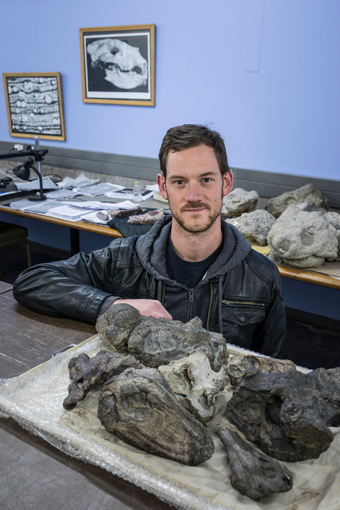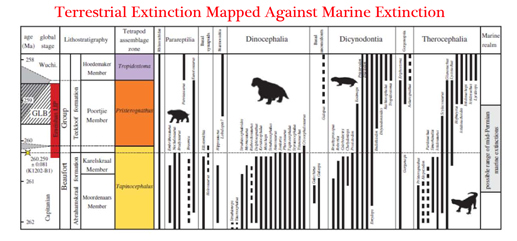New Study of Karoo Rocks Provides Fresh Insight into Extinction Event
Shedding Light on an Extinction Event from 260 Million Years Ago (Karoo Basin Fossils)
One global extinction event may have affected both terrestrial and marine biotas at the same time, some 260 million years ago, a study of Karoo Basin fossils is helping to shed light on ancient mass extinctions. With all the news recently of our planet entering a sixth mass extinction, studies into previous extinction events can help scientists to model and predict the impact of future events on environments and the species that live within them.
Karoo Basin Fossils
An international team led by researchers from the Evolutionary Studies Institute (ESI) at the University of the Witwatersrand, (Johannesburg), has obtained an age from rocks of the Great Karoo that shed light on the timing of a mass extinction event that occurred around 260 million years ago. The Great Karoo refers to a enormous sequence of rocks often cited as the “Karoo Supergroup”, which consists of mostly non marine sandstones and shales that represent a vast tract of geological time, from the Carboniferous through to the Jurassic.
This research focused on exploring fossils from the Beaufort unit, a sequence of rocks that were laid down in South Africa from the Middle Permian through to the Early Triassic. These rocks provide a record of the plants, invertebrates and vertebrates that thrived in the semi-arid conditions found in southern Africa during the Permian and Triassic. In particular, they provide evidence of the wide variety of terrestrial vertebrates that lived at this time, the forerunners of today’s reptiles and mammals.
A Mass Extinction Event
The mass extinction event of 260 million years ago led to the disappearance of a diverse group of early mammal-like reptiles called dinocephalians, which were the largest land-living animals of the time. Dinocephalians, were large bodied and evolved into a variety of forms including carnivores and herbivores. They were synapsids and as such, ancestral to modern mammals.
The research project was led by Dr Michael Day, (postdoctoral fellow at Wits University), the findings have been published today in the Royal Society’s biological journal, “Proceedings of the Royal Society B.” The paper is entitled: “When and how did the terrestrial Mid-Permian mass extinction occur? Evidence from the tetrapod record of the Karoo Basin, South Africa.”
Permian and Triassic Periods
The Karoo is very rich in fossils of terrestrial animals from the Permian and Triassic geological periods, which makes it one of the few places to study extinction events on land during this time. As a result, South Africa’s Karoo region provides not only a historical record of biological change over a period of Earth’s history but also a means to test theories of evolutionary processes over long stretches of time. By collecting fossils in the Eastern, Western and Northern Cape Provinces the team was able to show that around 74–80% of species became extinct along with the dinocephalians in a geologically short period of time.
Dr Michael Day with Some of the Fossils Used in the Study (Cranial Material)
Picture credit: Wits University
Calculating the Extinction Date
The new date was obtained by high precision analysis of the relative abundance of uranium and lead in small zircon crystals from a volcanic ash layer close to this extinction horizon in the Karoo. This provides a means of linking the South African fossil record with the fossil record in the rest of the world. In particular, it helps correlate the Karoo with the global marine record, which also records an extinction event around 260 million years ago.
Dr Day explained:
“A Mid-Permian extinction event on land has been known for some time but was suspected to have occurred earlier than those in the marine realm. The new date suggests that one event may have affected marine and terrestrial environments at the same time, which could mean its impact was greater than we thought.”
Mid-Permian Extinction
The Mid-Permian extinction occurred near the end of what geologists call the Guadalupian epoch that extended from 272.3 to around 259.1 million years ago. It pre-dated the massive and much more famous end-Permian mass extinction event by 8 million years.
Mid-Permian Terrestrial Extinction Plotted Against Proposed Marine Extinction Dates
Table credit: Proceedings of the Royal Society B.
Dinocephalia Demise
The table shows that in this new study of Karoo fauna, the demise of the Dinocephalia can be clearly mapped to a marine extinction event (marked by the yellow star). The marine extinction event has been identified through a study in the change of marine fossils deposited in strata from China (Wuchiapingian age, which has been dated to around 260 million years ago).
The scientists have therefore concluded that one global event may have affected both marine and terrestrial environments simultaneously. The impact of this event was greater than previously thought.
Dr Day added:
“The South African Karoo rocks host the richest record of Middle Permian land-living vertebrate animals. This dataset, the culmination of 30 years of fossil collecting and diligent stratigraphic recording of the information, for the first time provides robust fossil and radioisotopic data to support the occurrence of this extinction event on land.”
Dating the Formation
Jahandar Ramezani (Massachusetts Institute of Technology), was responsible for dating the stratigraphic sequences using the zircon uranium to lead degradation study (CA-TIMS method). Dr Ramezani, of the Department of Earth and Planetary Sciences at the Massachusetts Institute of Technology commented:
“The exact age of the marine extinctions remains uncertain, but this new date from terrestrial deposits of the Karoo, supported by palaeontological evidence, represents an important step towards a better understanding of the Mid-Permian extinction and its effect on terrestrial faunas.”
For models and replicas of Permian and Triassic prehistoric animals: CollectA Prehistoric Life Models.



